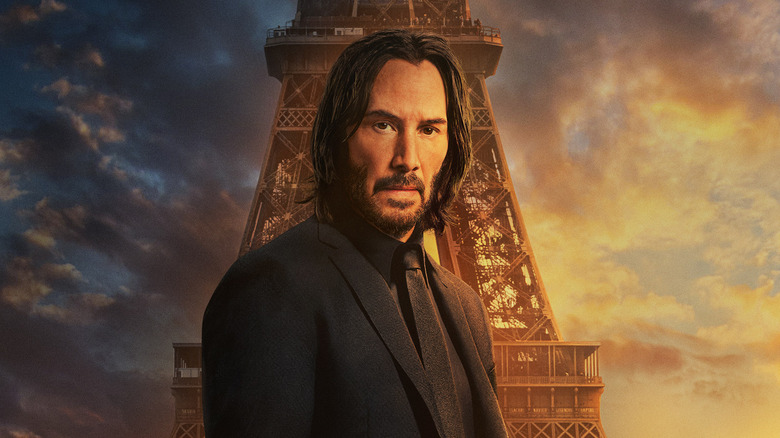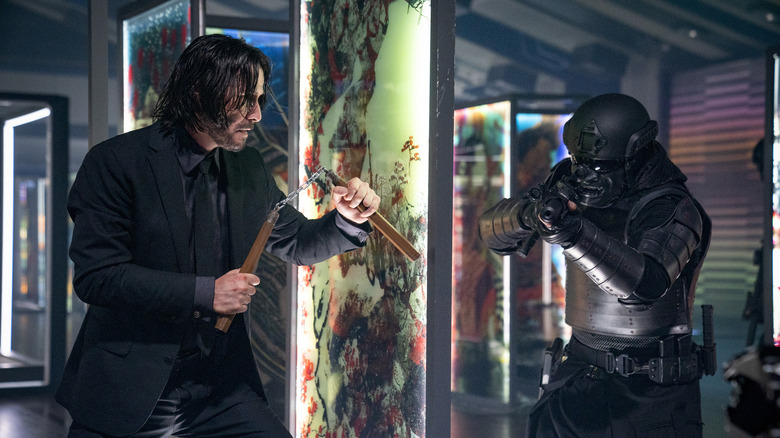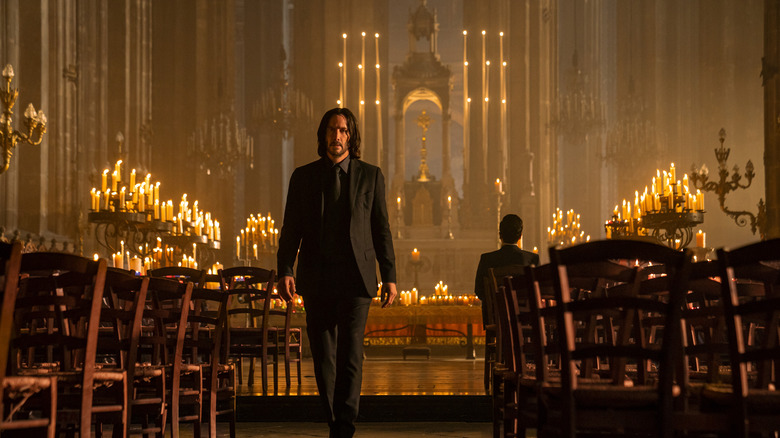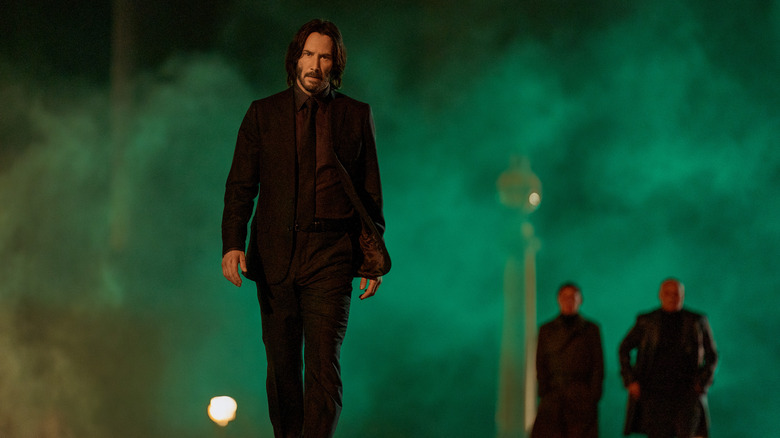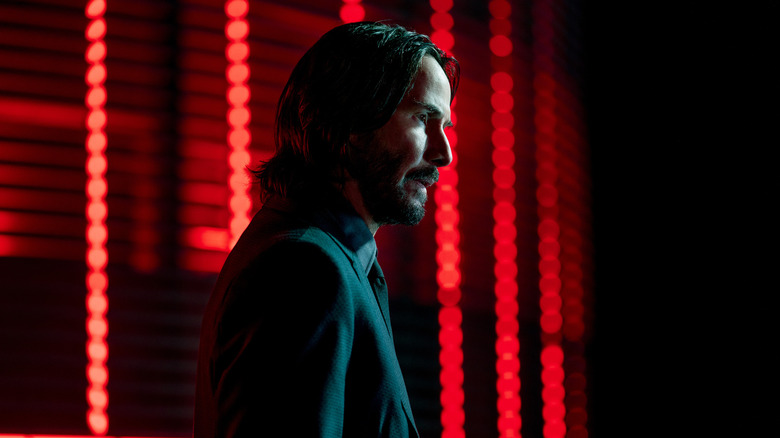John Wick 4 Director On Giving The Film's Epic Fight Scenes Room To Breathe [Exclusive Interview]
"John Wick: Chapter 4" is still a few weeks away, but critics (including myself) are calling it the best "Wick" film yet. That's no small praise for a fourth movie in a popular franchise, but director Chad Stahelski and his team have pulled it off, largely because they wouldn't have made the movie if they didn't think they could top themselves.
"You can't just go bigger," Stahelski explained to me in my conversation with him about the film. "You can't just go more explosions. You have this circumference of excellence that if everybody does their one inch of growth, you get a bigger circumference. And that's what I think we keep doing in the 'Wicks' is, if we all trust each other to get a little bit better at what we do, the synergistic effect is much greater than any one person trying to do a bigger explosion."
That's not to say that "John Wick 4" doesn't have bigger explosions. And bigger set pieces. And a bigger story. Stahelski and I talked about it all, including the film's musical cadence and epic inspiration, as well as whether he's in for a fifth "Wick" film. Read on for the full discussion, which doesn't spoil anything you haven't seen already in a trailer.
Note: This interview has been lightly edited for clarity and brevity.
'It's bop, bop, bop or bop ... bop ... bop'
This is a much bigger film with a lot of amazing action scenes, which I want to get into, but it's still grounded in terms of spending time with the characters. When you were crafting the story and putting it all together, how did you determine when to go from those major impressive action scenes to those quieter moments with the characters?
I'm a big fan of a lot of the '70s films, and there was just a different pacing for that era, like with Butch and Sundance [in "Butch Cassidy and the Sundance Kid"]. Sometimes it works, sometimes it doesn't. But sometimes that slow build really helps. So how do you mix action with the slow build?
I have a friend, Tyler Bates, who's a very good composer. We've had a lot of theoretical and philosophical talks about music and the magic of music and what music really is. A lot of great composers always define it by the space in between notes and not the actual notes. It's bop, bop, bop or bop ... bop ... bop. So we started playing with that. We've done so many fight scenes with my company, my team at 87eleven, and you can't always do a "John Wick." Sometimes there's just little fights, unfortunately.
But you play with rhythm, and your theoretical idea is, "How do we make this interesting?" Bop, bop, bop, bop, bah. And then if you listen to some of the soundtracks in "John Wick," the guns are actually taking up one of the musical tracks. There's just a beat — bom, bom, bom. Where the count is going — ba-bap-bap, ba-bap-bap, ba-bap-bap. So you're doing a little bit of a tango riff on the gunshots there. We thought it was fun just to even try and see if anybody got it.
So to your point, you try to look at the whole picture as a pacing thing. It's not just a sequence, it's not just an acting scene. When we write the script, we have an idea what this rhythm is, and you try to be at least 50%, 60% on. When you're in editorial ... there was one version where we had the Arc de Triomphe [which you see in the trailer] and the top shot on the stairs right on each other, but you need to cut back to Bill [Skarsgård], you need to catch up. You need to let the audience take a breath after Rina [Sawayama] climbs up the guy [which you also see in the trailer] and, ta ta ta, and ice picks him. You need those three seconds of her just going, "Ah!" just to re-acclimate yourself. But you don't really know that when you're shooting, when you're writing. That's something you have to watch and feel and go, "Why was that not satisfying? Oh, well, I didn't give it room to breathe."
I think if you look at that in the micro, the macro, it's about, "What is that great pause beat?" You need Keanu to stand up and just hit that pose and look exhausted in the waterfall. That one great shot of him just going, "Ugh." I need that. The audience needs that to go, "What the? Oh! There's more. Okay." But if you don't go, "Whoa," then it's just monotony, just da da da da da slamming you in the face with action.
'If I take a punch and a kick and I put it in this little room, now you're only looking at the people's ability'
Another thing I was really taken by was how each location had a very specific feel and a presence. You've said you had Odysseus in mind when making this movie. I wanted to talk a little bit more about that mindset in terms of the set pieces. When you're crafting the look of each place, both the quiet moments and the fight scenes, how did you approach that? And was there any specific throughline or mantra for putting those together?
There's definitely a lot of thought put in to it. You brought up Odysseus, when you really get into Homer's works and you're following Odysseus, look at the trials he went through, or Hercules' tasks, or anything like that. What makes him so memorable? Why are we still talking about it thousands of years later? The sirens, the minotaur, or the Golden Fleece or whatever. They're interesting, they're very unique, and they help paint the picture of the task.
If you can picture Odysseus in his journey tied to the mast, and the sirens are calling — that's worldbuilding. That's not just action, is it? They're wrapping it and showing you something about him — about fortitude, about resilience, about all this stuff. We've taken a lot of cues from that.
It seems very separate, right? It seems very macro and philosophical, but I kid you not, that's literally how we choreograph. We take mythological ways ... you look at Joseph Campbell's storytelling ability — you put a hero in a tree, you throw rocks at him so the audience feels for him, and then you let him solve his own problem. It's not ex-machina-ed out — they have to solve their own problems. But until the audience understands their problems, they can't empathize with them.
So we just try to do the same thing. The other thing is, if I take a punch and a kick and I put it in this little room, now you're only looking at the people's ability: "Oh, that's a really nice kick. That's a really nice punch." But if I put those same two people against the Eiffel Tower, now you're looking at the two people, the skill, and the Eiffel Tower. And now for some reason, that same punch and kick looks amazing to you: "Oh my god, you remember that?!" But it was just a punch and kick.
'If it's not beautiful, why are we doing it?'
We learned from some of the best choreographers out there, both dance and martial arts, from Jackie Chan, Sammo Hung, Yuen Biao, Jet Lee, Yuen Woo-ping, Yuen Chen, Yuen Kuai — all these great Hong Kong choreographers or Chinese choreographers and Japanese choreographers from Zatoichi and from Kurosawa's films. Then you lay that on to the great dance films of all time. The stage makes a big difference in how you attribute the dancers. You can have the world's best ballerina, but if it's in a boring spot in this little room, yes, you'll really appreciate her, but if she was doing it on this grand stage, for some reason, you sustain interest longer.
So we took that from live shows and dances and went, "Okay, we already have a good product. Let's put a great wrapper on it and let's present it to you in a way that's a little subversive and different than you're used to."
If you look at the Arc de Triomphe, you've seen guys spin cars before, you just haven't seen it the way we did. You've seen Keanu shoot at people, but you haven't seen it in the middle of five lanes of traffic. You've seen a fight scene before, but you haven't seen it in a club with 40 waterfalls. So we're constantly trying to change that.
Now you add in — I'm a huge Wong Kar-wai or a Zhang Yimou fan, so "The Grandmasters" or "In the Mood for Love" or the color palettes. You take Roger Deakins or Bob Richardson, the great cinematographers from our world, and what color can mean emotionally, and you play with that. We know we're making this goofy, modern day fantasy action movie that combines samurai, wuxia, dogs, cars, guns, whatever, but we still see ourselves as artsy filmmakers.
So we're trying a lot of stuff. I think with all my crew, we have this little mantra of, "If it's not beautiful, why are we doing it?" I consider myself very much a craftsman, and my crew are craftsmen, with the dream of becoming an artist. We're very good at what we do technically, but it's the translation of what we do into that next level that becomes artistry. So we just figured, "Well, why not? We might as well try to be artists, and given enough practice and the right amount of time and the right opportunity, maybe we will one day do something that's worthy of that."
But just because we're doing an action movie doesn't mean we shouldn't care about all those little things or strive to be artistic in that and how to change it. I think the only way you can do is multi-dimensional. You can't just go bigger. You can't just go more explosions. You have this circumference of excellence that if everybody does their one inch of growth, you get a bigger circumference. And that's what I think we keep doing in the "Wicks" is, if we all trust each other to get a little bit better at what we do, the synergistic effect is much greater than any one person trying to do a bigger explosion. That's just the attitude we've gone through.
'This is my last one'
Speaking of more potential "Wicks," I know there's a "John Wick 5" out there —
Somewhere, maybe somebody will do it.
Is there anything you can say about a fifth movie in terms of if you wanted to do it or if you don't?
We've always done the same process. If you go back to interviews over the last couple years, I'm always saying, "This is my last one, this will never happen again." And I'll say that now: this is my last one.
It's very flattering when they ask you to do more. That means people like what you're doing and people want to pay for you to do it. That's so flattering. We're so appreciative of that. But the way I work, the way I think, is if I don't grow and experience life better as a person, I can't get to be a better director. So if you had me do three "Wicks" in a row, I think they would unequivocally become worse with each one because I don't have time to assess my mistakes and get better and experience things and get inspired again and have that breath, that space in between notes. I'd just be a one-note guy at that point.
Every time I come back to a "Wick," there's been two or three years in between. That's a lot of time for a human. You know how many pieces of art or music or museums or locations I've gone to in three years? Huge. I mean, think of what you do in a year. What would you do in three? Don't you think all that would influence you? I just don't think I'd be very good jumping right into something. I need a little bit of time to get better. I've got to go practice.
I tried to get better as a storyteller in this one, but I'd be the same guy jumping back into the next one. I've got to get better. Keanu's out there every day getting better — he's acting, he's trying new projects. I've got to sit in a room and go, "Okay, how do I get better as a director?" I don't have the same choices. So I can't just direct, direct, direct. I'd have no time to expand. I just think I'd get s***tier and s***tier. So I just think, in loyalty to the franchise, I need to get a hell of a lot better before I try to find [another story]. Because otherwise, if you're not going to get better, if you're not going to do something different, if you're not going to try to expand and be artistically better, that's kind of lame just to do it for a paycheck.
Do you have any idea what you want to do next?
I'd like to do a good press tour. Come home and sit with my dogs. [laughs] I'm super lucky. I'm attached to some really great projects from "Rainbow Six" to "Ghost of Tsushima," some of these other great projects that we got going on, both movies and television. And I love them all. I mean, Hollywood is a bit of algorithm. It's like, cast, logistics, money, can it all get in the same spot? So if any one of these things got their ducks in a row first, I'd be more than proud to do any of them. So I'm really excited about what comes next. I don't know exactly, but I have a pretty good idea.
"John Wick: Chapter 4" premieres in theaters on March 24, 2023.
